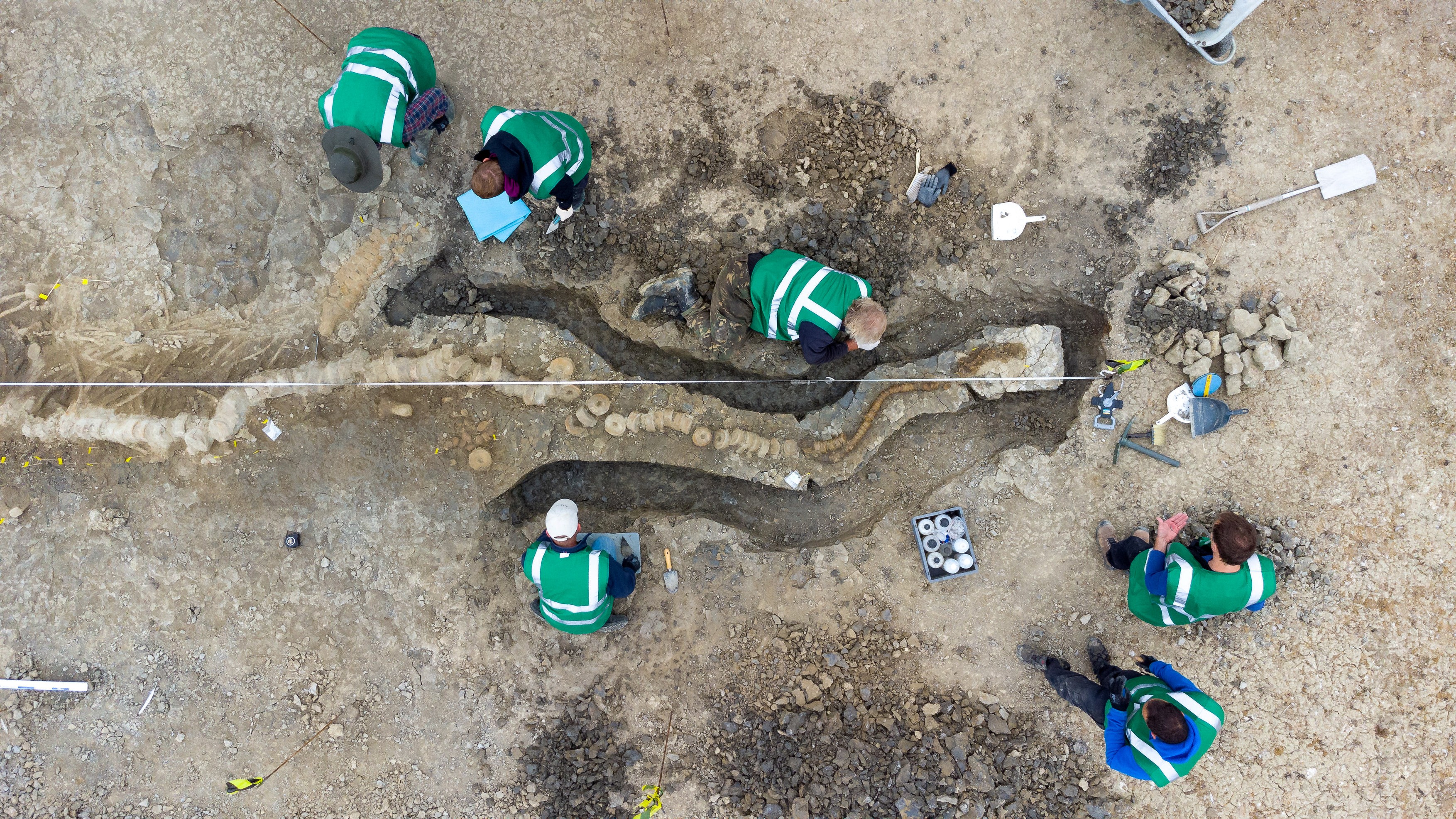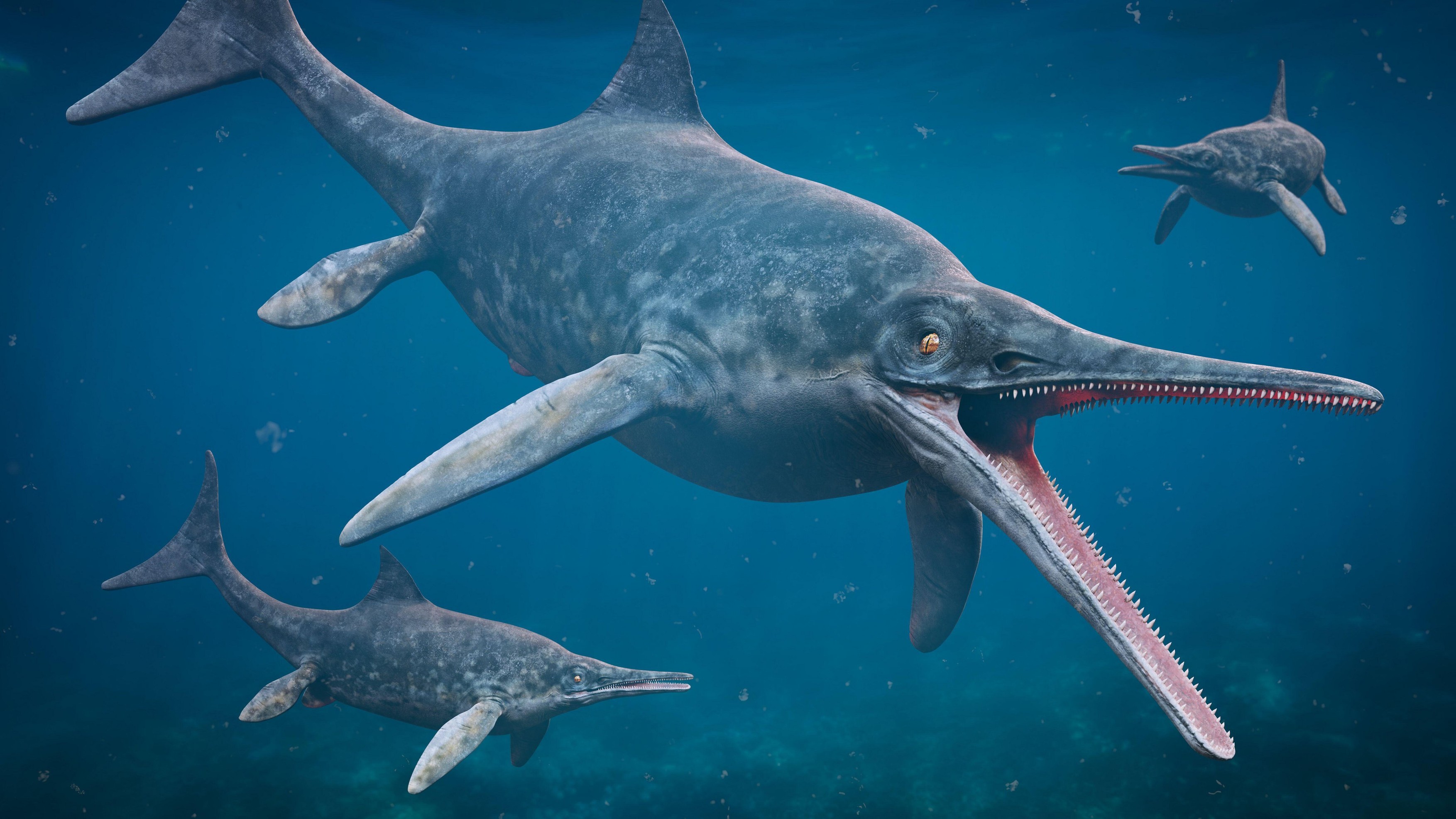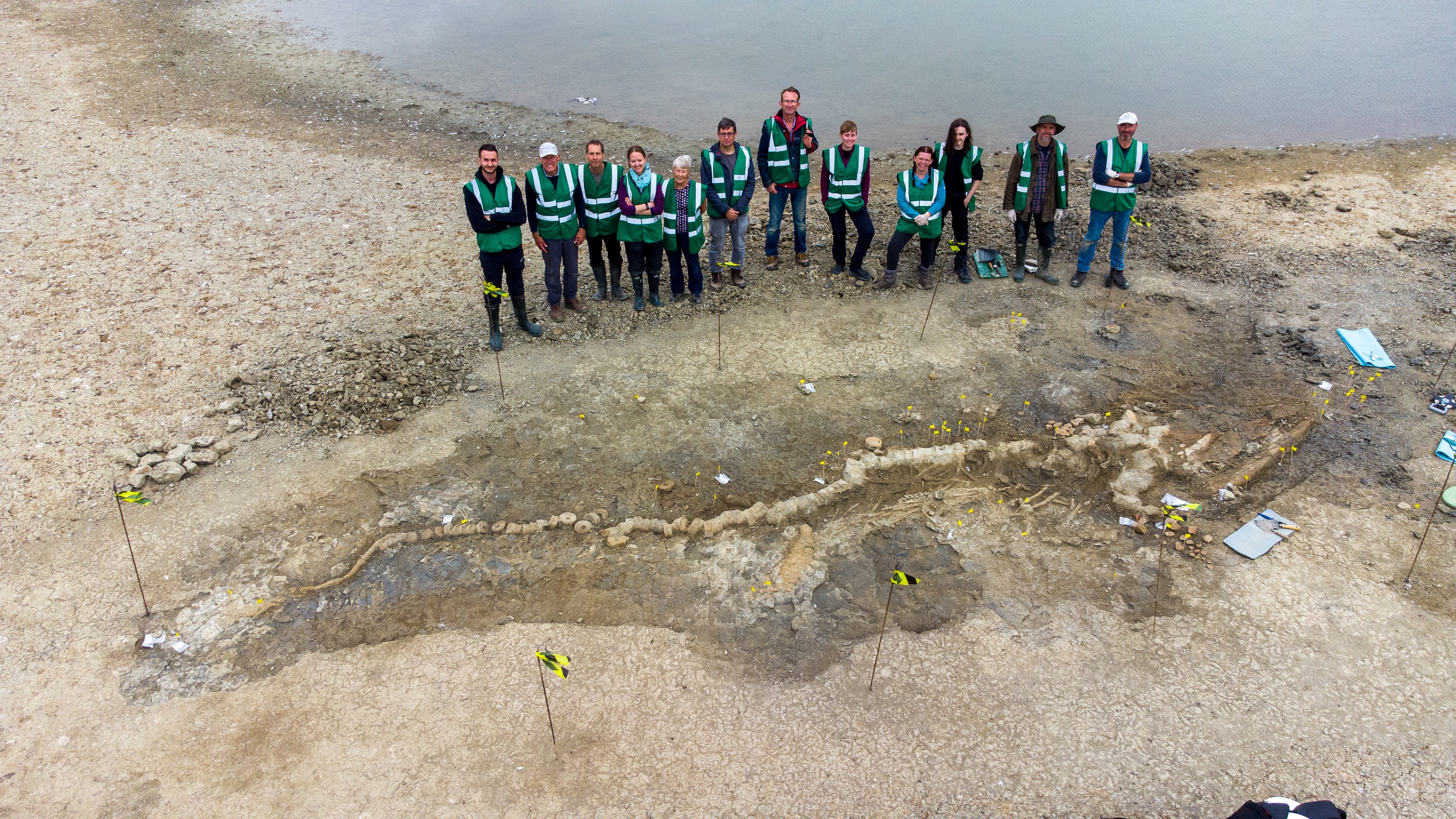FOTO // „Monstrul apelor”, descoperit pe fundul unui lac din Marea Britanie: Creatura avea 10 metri lungime
Pe fundul unui lac de acumulare din Marea Britanie a fost descoperită cea mai completă fosilă a unei reptile preistorice, un monstru marin de 10 metri lungime care a trăit acum 180 de milioane de ani.
Ihtiozaurii sau „șopârlele-pește” au fost primele reptile complet adaptate la viața acvatică. Au trăit într-un interval situat între acum 250 de milioane și acum 90 de milioane de ani.
Cu un schelet care măsoară aproximativ 10 metri lungime și un craniu cântărind aproximativ o tonă, este cea mai mare și mai completă fosilă de acest gen găsită vreodată în Marea Britanie, scrie The Guardian.
Joe Davis de la Leicestershire and Rutland Wildlife Trust l-a descoperit în timpul drenării de rutină a unei insule din rezervorul de apă Rutland, în februarie 2021. Un angajat a văzut fosila unui animal foarte mare, a crezut inițial că este un fel de dinozaur, dar paleontologii chemați și-au dat seama că este un exemplar extrem de rar de ihtiozaur.
Primii ihtiozauri, care sunt numiți dragoni de mare pentru că au tendința de a avea dinți și ochi foarte mari, au fost descoperiți de către vânătorul de fosile și paleontologul Mary Anning la începutul secolului al XIX-lea.
„În ciuda numeroaselor fosile de ihtiozaur găsite în Marea Britanie, este remarcabil că este cel mai mare schelet găsit vreodată în Marea Britanie. Este o descoperire cu adevărat fără precedent și una dintre cele mai mari descoperiri din istoria paleontologică britanică”, spune paleontologul Dean Lomax, notează Digi24.
Ihtiozaurii, care erau reptile marine, au apărut pentru prima dată în urmă cu aproximativ 250 de milioane de ani și au dispărut în urmă cu 90 de milioane de ani. Lungimea lor a variat de la 1 metru la mai mult de 25 de metri și semănau cu delfinii ca formă generală a corpului.
 The fossilised remains of Britainââ¬â¢s LARGEST ichthyosaur, commonly known as a Sea Dragon, have been found in Leicestershire.
The 180 million year-old ichthyosaur, nicknamed ââ¬ï¿½The Rutland Sea Dragonââ¬â¢, was discovered at Rutland Water Nature Reserve, which is owned and run by Anglian Water.
It is the biggest and most complete skeleton of its kind found to date in the UK and is also thought to be the first ichthyosaur of its species found in the country.
The remains were fully excavated earlier this year and will feature on BBC Twoââ¬â¢s Digging for Britain tomorrow (Jan 11) before being made available on BBC iPlayer.
The ichthyosaur was discovered by Joe Davis, Conservation Team Leader at Leicestershire and Rutland Wildlife Trust, who operates the nature reserve in partnership with the water company, during the routine draining of a lagoon island for re-landscaping at Rutland Water in February 2021.
Joe Davis said: ââ¬ÅThe find has been absolutely fascinating and a real career highlight, itââ¬â¢s great to learn so much from the discovery and to think that this amazing creature was once swimming in seas above us, and now once again Rutland Water is a haven for wetland wildlife albeit on a smaller scale!ââ¬Å¥
The ichthyosaur is approximately 180 million years old and, with a skeleton measuring around 10 metres in length and a skull weighing approximately one tonne, it is the most complete large ichthyosaur ever found in Britain.
Ichthyosaurs first appeared around 250 million years ago and went extinct 90 million years ago. They were an extraordinary group of marine reptiles that varied in size from 1 to more than 25 metres in length, and resembled dolphins in general body shape.
The fragile remains of the huge skeleton were carefully excavated in August and September 2021 by a team of expert palaeontologists assembled from around the UK, in partnership with Anglian Water, Rutland County Council and the Leicestershire and Rutland Wildlife Trust.
The excavation was led by world ichthyosaur expert Dr Dean Lomax and specialist palaeontological conservator Nigel Larkin, along with marine reptile specialist Dr Mark Evans, Dr Emma Nicholls from the Horniman Museum and volunteers with experience of excavating fossilised marine reptiles.
Pictured: Rutland Sea Dragon aerial shot,Image: 651629580, License: Rights-managed, Restrictions: -ALLCOUNTRY, Model Release: no, Pictured: Rutland Sea Dragon aerial shot, Credit line: Profimedia
The fossilised remains of Britainââ¬â¢s LARGEST ichthyosaur, commonly known as a Sea Dragon, have been found in Leicestershire.
The 180 million year-old ichthyosaur, nicknamed ââ¬ï¿½The Rutland Sea Dragonââ¬â¢, was discovered at Rutland Water Nature Reserve, which is owned and run by Anglian Water.
It is the biggest and most complete skeleton of its kind found to date in the UK and is also thought to be the first ichthyosaur of its species found in the country.
The remains were fully excavated earlier this year and will feature on BBC Twoââ¬â¢s Digging for Britain tomorrow (Jan 11) before being made available on BBC iPlayer.
The ichthyosaur was discovered by Joe Davis, Conservation Team Leader at Leicestershire and Rutland Wildlife Trust, who operates the nature reserve in partnership with the water company, during the routine draining of a lagoon island for re-landscaping at Rutland Water in February 2021.
Joe Davis said: ââ¬ÅThe find has been absolutely fascinating and a real career highlight, itââ¬â¢s great to learn so much from the discovery and to think that this amazing creature was once swimming in seas above us, and now once again Rutland Water is a haven for wetland wildlife albeit on a smaller scale!ââ¬Å¥
The ichthyosaur is approximately 180 million years old and, with a skeleton measuring around 10 metres in length and a skull weighing approximately one tonne, it is the most complete large ichthyosaur ever found in Britain.
Ichthyosaurs first appeared around 250 million years ago and went extinct 90 million years ago. They were an extraordinary group of marine reptiles that varied in size from 1 to more than 25 metres in length, and resembled dolphins in general body shape.
The fragile remains of the huge skeleton were carefully excavated in August and September 2021 by a team of expert palaeontologists assembled from around the UK, in partnership with Anglian Water, Rutland County Council and the Leicestershire and Rutland Wildlife Trust.
The excavation was led by world ichthyosaur expert Dr Dean Lomax and specialist palaeontological conservator Nigel Larkin, along with marine reptile specialist Dr Mark Evans, Dr Emma Nicholls from the Horniman Museum and volunteers with experience of excavating fossilised marine reptiles.
Pictured: Rutland Sea Dragon aerial shot,Image: 651629580, License: Rights-managed, Restrictions: -ALLCOUNTRY, Model Release: no, Pictured: Rutland Sea Dragon aerial shot, Credit line: Profimedia Image: 629135900, License: Royalty-free, Restrictions: , Model Release: no, Credit line: Profimedia
Image: 629135900, License: Royalty-free, Restrictions: , Model Release: no, Credit line: Profimedia The fossilised remains of Britainââ¬â¢s LARGEST ichthyosaur, commonly known as a Sea Dragon, have been found in Leicestershire.
The 180 million year-old ichthyosaur, nicknamed ââ¬ï¿½The Rutland Sea Dragonââ¬â¢, was discovered at Rutland Water Nature Reserve, which is owned and run by Anglian Water.
It is the biggest and most complete skeleton of its kind found to date in the UK and is also thought to be the first ichthyosaur of its species found in the country.
The remains were fully excavated earlier this year and will feature on BBC Twoââ¬â¢s Digging for Britain tomorrow (Jan 11) before being made available on BBC iPlayer.
The ichthyosaur was discovered by Joe Davis, Conservation Team Leader at Leicestershire and Rutland Wildlife Trust, who operates the nature reserve in partnership with the water company, during the routine draining of a lagoon island for re-landscaping at Rutland Water in February 2021.
Joe Davis said: ââ¬ÅThe find has been absolutely fascinating and a real career highlight, itââ¬â¢s great to learn so much from the discovery and to think that this amazing creature was once swimming in seas above us, and now once again Rutland Water is a haven for wetland wildlife albeit on a smaller scale!ââ¬Å¥
The ichthyosaur is approximately 180 million years old and, with a skeleton measuring around 10 metres in length and a skull weighing approximately one tonne, it is the most complete large ichthyosaur ever found in Britain.
Ichthyosaurs first appeared around 250 million years ago and went extinct 90 million years ago. They were an extraordinary group of marine reptiles that varied in size from 1 to more than 25 metres in length, and resembled dolphins in general body shape.
The fragile remains of the huge skeleton were carefully excavated in August and September 2021 by a team of expert palaeontologists assembled from around the UK, in partnership with Anglian Water, Rutland County Council and the Leicestershire and Rutland Wildlife Trust.
The excavation was led by world ichthyosaur expert Dr Dean Lomax and specialist palaeontological conservator Nigel Larkin, along with marine reptile specialist Dr Mark Evans, Dr Emma Nicholls from the Horniman Museum and volunteers with experience of excavating fossilised marine reptiles.
Pictured: Rutland Sea Dragon aerial shot,Image: 651629642, License: Rights-managed, Restrictions: -ALLCOUNTRY, Model Release: no, Pictured: Rutland Sea Dragon aerial shot, Credit line: Profimedia
The fossilised remains of Britainââ¬â¢s LARGEST ichthyosaur, commonly known as a Sea Dragon, have been found in Leicestershire.
The 180 million year-old ichthyosaur, nicknamed ââ¬ï¿½The Rutland Sea Dragonââ¬â¢, was discovered at Rutland Water Nature Reserve, which is owned and run by Anglian Water.
It is the biggest and most complete skeleton of its kind found to date in the UK and is also thought to be the first ichthyosaur of its species found in the country.
The remains were fully excavated earlier this year and will feature on BBC Twoââ¬â¢s Digging for Britain tomorrow (Jan 11) before being made available on BBC iPlayer.
The ichthyosaur was discovered by Joe Davis, Conservation Team Leader at Leicestershire and Rutland Wildlife Trust, who operates the nature reserve in partnership with the water company, during the routine draining of a lagoon island for re-landscaping at Rutland Water in February 2021.
Joe Davis said: ââ¬ÅThe find has been absolutely fascinating and a real career highlight, itââ¬â¢s great to learn so much from the discovery and to think that this amazing creature was once swimming in seas above us, and now once again Rutland Water is a haven for wetland wildlife albeit on a smaller scale!ââ¬Å¥
The ichthyosaur is approximately 180 million years old and, with a skeleton measuring around 10 metres in length and a skull weighing approximately one tonne, it is the most complete large ichthyosaur ever found in Britain.
Ichthyosaurs first appeared around 250 million years ago and went extinct 90 million years ago. They were an extraordinary group of marine reptiles that varied in size from 1 to more than 25 metres in length, and resembled dolphins in general body shape.
The fragile remains of the huge skeleton were carefully excavated in August and September 2021 by a team of expert palaeontologists assembled from around the UK, in partnership with Anglian Water, Rutland County Council and the Leicestershire and Rutland Wildlife Trust.
The excavation was led by world ichthyosaur expert Dr Dean Lomax and specialist palaeontological conservator Nigel Larkin, along with marine reptile specialist Dr Mark Evans, Dr Emma Nicholls from the Horniman Museum and volunteers with experience of excavating fossilised marine reptiles.
Pictured: Rutland Sea Dragon aerial shot,Image: 651629642, License: Rights-managed, Restrictions: -ALLCOUNTRY, Model Release: no, Pictured: Rutland Sea Dragon aerial shot, Credit line: Profimedia





comentarii: